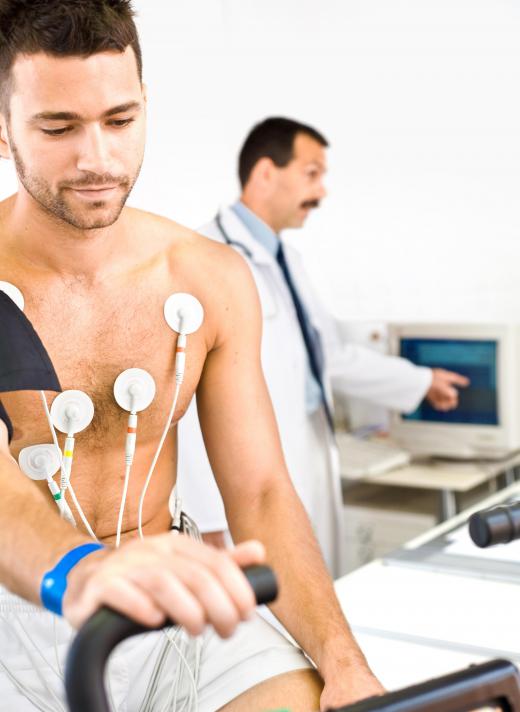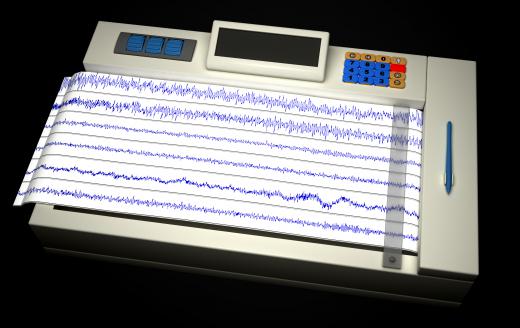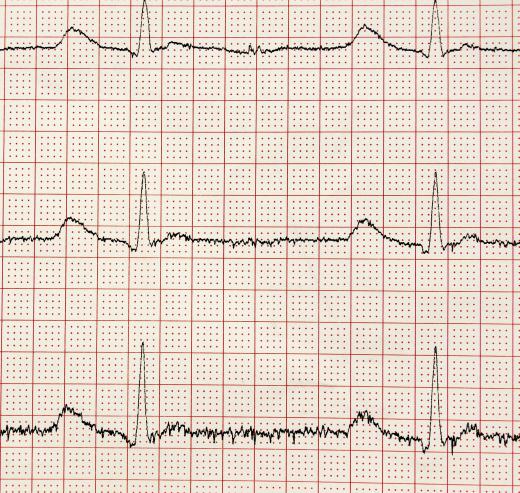What is an Electrode?
 Nicole Madison
Nicole Madison
An electrode is a conductor that passes an electrical current from one medium to another, usually from a power source to a device or material. It can take a number of different forms, including a wire, a plate, or a rod, and is most commonly made of metal, such as copper, silver, lead, or zinc, but can also be made of a non-metallic substance that conducts electricity, such as graphite. Electrodes are used in welding, electroplating, batteries, medicine, and in industry for processes involving electrolysis.
Anodes and Cathodes

In the case of a direct (DC) current, electrodes come in pairs, and are known as anodes and cathodes. For a battery, or other DC source, the cathode is defined as the electrode from which the current leaves, and the anode as the point where it returns. For reasons that are historical rather than scientific, electricity in a circuit is, by convention, depicted as traveling from positive to negative, so that it is seen as a flow of positive charge out from the cathode, and into the anode. An electrical current, however, consists of a flow of tiny negatively charged particles called electrons, so this flow is actually in the opposite direction. In this context, it is probably better to think simply in terms of positive and negative terminals.

Inside a battery, or electrochemical cell, the electrodes are made of different materials, one of which gives up electrons more easily than the other. They are kept in contact with a conducting chemical that can split into positively and negatively charged ions. When a circuit is completed, in other words, when the battery is connected to an electrical device, such as a light bulb, a redox reaction takes place within the cell. This means that the conducting chemical gains electrons at one electrode — a process known as reduction — and loses them at the other — a process called oxidation — with the result that the electrons flow as a current round the circuit. Reduction always takes place at the cathode, and oxidation at the anode.

In a rechargeable battery, this process is reversed while the battery is charging. An electrical current from another source is used to power a redox reaction in the opposite direction, which means that the anode becomes the cathode and vice-versa. It is still the case that reduction takes place at the cathode and oxidation at the anode, but the direction of the current is reversed, so which electrode is negative and which is positive depends on whether the battery is supplying current or recharging. Sometimes cells are connected together by an electrode, which acts as the anode for one cell and the cathode for the other. This is known as a bipolar electrode.

In the case of an alternating (AC) current, there is no distinction between anode and cathode. This is because the current is constantly reversing direction, many times per second. An electrode using this type of current would therefore constantly switch between negative and positive.
Electrolysis
In this process, a DC current flows through a conducting liquid medium from a cathode to an anode, allowing reduction and oxidation processes to take place. This is a very useful way of producing certain chemicals and, in particular, isolating chemical elements from their compounds. In the case of some very reactive elements, it is the only practical way of doing so.

To obtain a given element, an ionic compound of that element can be electrolyzed. An example is the production of sodium metal from molten salt, or sodium chloride. When the current flows, positively charged sodium ions are attracted to the negative electrode, or cathode, where they gain electrons, forming sodium metal. Negatively charged chloride ions are attracted to the anode, where they lose electrons, forming chlorine gas, which is also collected as a by-product.
Electroplating

In this process, a metal object is coated with another metal to improve its corrosion resistance or appearance. The object to be coated forms the cathode in an electrolysis process by being immersed in a solution of a soluble compound of the metal that will form the coating, with the anode also made of this metal. When the current flows, positive metal ions from the solution are attracted to the cathode, and form a deposit on it. As the ions in solution are used up, they are replaced by ions that form from the anode. Sometimes, the anode is made from a different material that is not used up; in this method, the metal ions have to be replaced by topping up the solution.
Other Uses
Electrodes are used in arc welding, a technique for joining two pieces of metal using a large electric current. A consumable electrode melts, and provides the material that joins the metals. The non-consumable type is made from a material with a very high melting point, such as tungsten, and simply provides the heat to melt another material that forms the join. In medicine, electrodes may be used in an emergency to apply an electric current to the heart in a technique known as defibrillation. They are also used to record electrical activity in the brain during an electroencephalogram (EEG).
AS FEATURED ON:
AS FEATURED ON:
















Discussion Comments
I don't get which way current from anodes and cathodes flow.
What are the two most common electrodes used in a primary dry cell and wet cell?
Can you use any metal for the construction of an electrode?
An anode is an electrode at which current leaves the cell and oxidation takes place... A cathode is described as a negative electrode. Current enters the cell at the cathode and reduction takes place. Electrons are repelled from the cathode.
This is always a source of confusion, and your explanation is the reason why. This statement should be refined to reflect that *electron* current enters the anode, and leaves the cathode; while "regular" electric current leaves the anode (in opposite direction of the flow of electrons), and enters the cathode...
how will I know what kid of metal should I use as my positive and negative electrodes if I am going to make my own voltaic cell out of a potato?
Post your comments